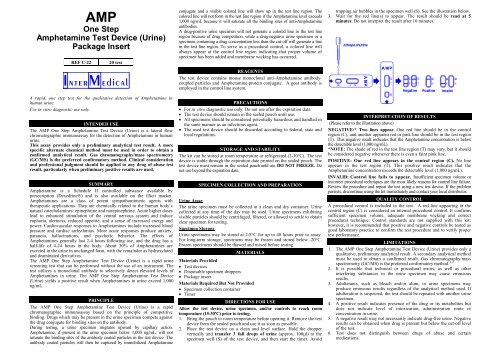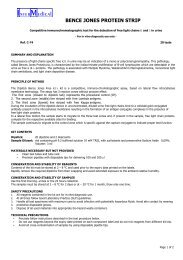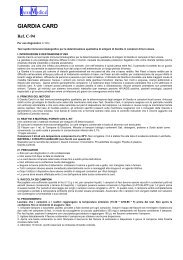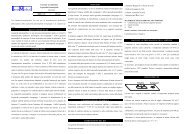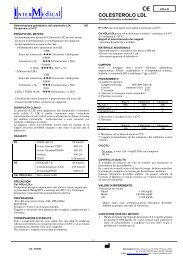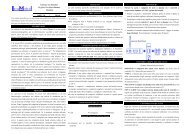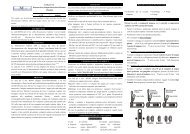Monofase Card per Test di Amfetamina (Urina ... - Intermedical.it
Monofase Card per Test di Amfetamina (Urina ... - Intermedical.it
Monofase Card per Test di Amfetamina (Urina ... - Intermedical.it
You also want an ePaper? Increase the reach of your titles
YUMPU automatically turns print PDFs into web optimized ePapers that Google loves.
AMP<br />
One Step<br />
Amphetamine <strong>Test</strong> Device (Urine)<br />
Package Insert<br />
REF C-22 20 test<br />
A rapid, one step test for the qual<strong>it</strong>ative detection of Amphetamine in<br />
human urine.<br />
For in v<strong>it</strong>ro <strong>di</strong>agnostic use only.<br />
INTENDED USE<br />
The AMP One Step Amphetamine <strong>Test</strong> Device (Urine) is a lateral flow<br />
chromatographic immunoassay for the detection of Amphetamine in human<br />
urine.<br />
This assay provides only a preliminary analytical test result. A more<br />
specific alternate chemical method must be used in order to obtain a<br />
confirmed analytical result. Gas chromatography/mass spectrometry<br />
(GC/MS) is the preferred confirmatory method. Clinical consideration<br />
and professional judgment should be applied to any drug of abuse test<br />
result, particularly when preliminary pos<strong>it</strong>ive results are used.<br />
SUMMARY<br />
Amphetamine is a Schedule II controlled substance available by<br />
presecription (Dexedrine®) and is also availab le on the illic<strong>it</strong> market.<br />
Amphetamines are a class of potent sympathomimetic agents w<strong>it</strong>h<br />
therapeutic applications. They are chemically related to the human body’s<br />
natural catecholamines: epinephrine and norepinephrine. Acute higher doses<br />
lead to enhanced stimulation of the central nervous system and induce<br />
euphoria, alertness, reduced appet<strong>it</strong>e, and a sense of increased energy and<br />
power. <strong>Card</strong>iovascular responses to Amphetamines include increased blood<br />
pressure and car<strong>di</strong>ac arrhythmias. More acute responses produce anxiety,<br />
paranoia, hallucinations, and psychotic behavior. The effects of<br />
Amphetamines generally last 2-4 hours following use, and the drug has a<br />
half-life of 4-24 hours in the body. About 30% of Amphetamines are<br />
excreted in the urine in unchanged form, w<strong>it</strong>h the remainder as hydroxylated<br />
and deaminated derivatives.<br />
The AMP One Step Amphetamine <strong>Test</strong> Device (Urine) is a rapid urine<br />
screening test that can be <strong>per</strong>formed w<strong>it</strong>hout the use of an instrument. The<br />
test utilizes a monoclonal antibody to selectively detect elevated levels of<br />
Amphetamines in urine. The AMP One Step Amphetamine <strong>Test</strong> Device<br />
(Urine) yields a pos<strong>it</strong>ive result when Amphetamines in urine exceed 1,000<br />
ng/mL.<br />
PRINCIPLE<br />
The AMP One Step Amphetamine <strong>Test</strong> Device (Urine) is a rapid<br />
chromatographic immunoassay based on the principle of compet<strong>it</strong>ive<br />
bin<strong>di</strong>ng. Drugs which may be present in the urine specimen compete against<br />
the drug conjugate for bin<strong>di</strong>ng s<strong>it</strong>es on the antibody.<br />
During testing, a urine specimen migrates upward by capillary action.<br />
Amphetamine, if present in the urine specimen below 1,000 ng/mL, will not<br />
saturate the bin<strong>di</strong>ng s<strong>it</strong>es of the antibody coated particles in the test device. The<br />
antibody coated particles will then be captured by immobilized Amphetamine<br />
conjugate and a visible colored line will show up in the test line region. The<br />
colored line will not form in the test line region if the Amphetamine level exceeds<br />
1,000 ng/mL because <strong>it</strong> will saturate all the bin<strong>di</strong>ng s<strong>it</strong>es of anti-Amphetamine<br />
antibo<strong>di</strong>es.<br />
A drug-pos<strong>it</strong>ive urine specimen will not generate a colored line in the test line<br />
region because of drug compet<strong>it</strong>ion, while a drug-negative urine specimen or a<br />
specimen containing a drug concentration less than the cut-off will generate a line<br />
in the test line region. To serve as a procedural control, a colored line will<br />
always appear at the control line region in<strong>di</strong>cating that pro<strong>per</strong> volume of<br />
specimen has been added and membrane wicking has occurred.<br />
REAGENTS<br />
The test device contains mouse monoclonal anti-Amphetamine antibodycoupled<br />
particles and Amphetamine-protein conjugate. A goat antibody is<br />
employed in the control line system.<br />
PRECAUTIONS<br />
For in v<strong>it</strong>ro <strong>di</strong>agnostic use only. Do not use after the expiration date.<br />
The test device should remain in the sealed pouch until use.<br />
All specimens should be considered potentially hazardous and handled in<br />
the same manner as an infectious agent.<br />
The used test device should be <strong>di</strong>scarded accor<strong>di</strong>ng to federal, state and<br />
local regulations.<br />
STORAGE AND STABILITY<br />
The k<strong>it</strong> can be stored at room tem<strong>per</strong>ature or refrigerated (2-30°C). The test<br />
device is stable through the expiration date printed on the sealed pouch. The<br />
test device must remain in the sealed pouch until use. DO NOT FREEZE. Do<br />
not use beyond the expiration date.<br />
SPECIMEN COLLECTION AND PREPARATION<br />
Urine Assay<br />
The urine specimen must be collected in a clean and dry container. Urine<br />
collected at any time of the day may be used. Urine specimens exhib<strong>it</strong>ing<br />
visible particles should be centrifuged, filtered, or allowed to settle to obtain<br />
clear specimen for testing.<br />
Specimen Storage<br />
Urine specimens may be stored at 2-8°C for up to 48 hours prior to assay.<br />
For long-term storage, specimens may be frozen and stored below -20°C.<br />
Frozen specimens should be thawed and mixed before testing.<br />
MATERIALS<br />
Materials Provided<br />
<strong>Test</strong> devices<br />
Disposable specimen drop<strong>per</strong>s<br />
Package insert<br />
Materials Required But Not Provided<br />
Specimen collection container<br />
Timer<br />
DIRECTIONS FOR USE<br />
Allow the test device, urine specimen, and/or controls to reach room<br />
tem<strong>per</strong>ature (15-30ºC) prior to testing.<br />
1. Bring the pouch to room tem<strong>per</strong>ature before opening <strong>it</strong>. Remove the test<br />
device from the sealed pouch and use <strong>it</strong> as soon as possible.<br />
2. Place the test device on a clean and level surface. Hold the drop<strong>per</strong><br />
vertically and transfer 3 full drops of urine (approx. 100 l) to the<br />
specimen well (S) of the test device, and then start the timer. Avoid<br />
trapping air bubbles in the specimen well (S). See the illustration below.<br />
3. Wa<strong>it</strong> for the red line(s) to appear. The result should be read at 5<br />
minutes. Do not interpret the result after 10 minutes.<br />
INTERPRETATION OF RESULTS<br />
(Please refer to the illustration above)<br />
NEGATIVE:* Two lines appear. One red line should be in the control<br />
region (C), and another apparent red or pink line should be in the test region<br />
(T). This negative result in<strong>di</strong>cates that the Amphetamine concentration is below<br />
the detectable level (1,000 ng/mL).<br />
*NOTE: The shade of red in the test line region (T) may vary, but <strong>it</strong> should<br />
be considered negative whenever there is even a faint pink line.<br />
POSITIVE: One red line appears in the control region (C). No line<br />
appears in the test region (T). This pos<strong>it</strong>ive result in<strong>di</strong>cates that the<br />
Amphetamine concentration exceeds the detectable level (1,000 ng/mL).<br />
INVALID: Control line fails to appear. Insufficient specimen volume or<br />
incorrect procedural techniques are the most likely reasons for control line failure.<br />
Review the procedure and repeat the test using a new test device. If the problem<br />
<strong>per</strong>sists, <strong>di</strong>scontinue using the lot imme<strong>di</strong>ately and contact your local <strong>di</strong>stributor.<br />
QUALITY CONTROL<br />
A procedural control is included in the test. A red line appearing in the<br />
control region (C) is considered an internal procedural control. It confirms<br />
sufficient specimen volume, adequate membrane wicking and correct<br />
procedural technique. Control standards are not supplied w<strong>it</strong>h this k<strong>it</strong>;<br />
however, <strong>it</strong> is recommended that pos<strong>it</strong>ive and negative controls be tested as<br />
good laboratory practice to confirm the test procedure and to verify pro<strong>per</strong><br />
test <strong>per</strong>formance.<br />
LIMITATIONS<br />
1. The AMP One Step Amphetamine <strong>Test</strong> Device (Urine) provides only a<br />
qual<strong>it</strong>ative, preliminary analytical result. A secondary analytical method<br />
must be used to obtain a confirmed result. Gas chromatography/mass<br />
spectrometry (GC/MS) is the preferred confirmatory method. 1,2<br />
2. It is possible that technical or procedural errors, as well as other<br />
interfering substances in the urine specimen may cause erroneous<br />
results.<br />
3. Adulterants, such as bleach and/or alum, in urine specimens may<br />
produce erroneous results regardless of the analytical method used. If<br />
adulteration is suspected, the test should be repeated w<strong>it</strong>h another urine<br />
specimen.<br />
4. A pos<strong>it</strong>ive result in<strong>di</strong>cates presence of the drug or <strong>it</strong>s metabol<strong>it</strong>es but<br />
does not in<strong>di</strong>cate level of intoxication, administration route or<br />
concentration in urine.<br />
5. A negative result may not necessarily in<strong>di</strong>cate drug-free urine. Negative<br />
results can be obtained when drug is present but below the cut-off level<br />
of the test.<br />
6. <strong>Test</strong> does not <strong>di</strong>stinguish between drugs of abuse and certain<br />
me<strong>di</strong>cations.


